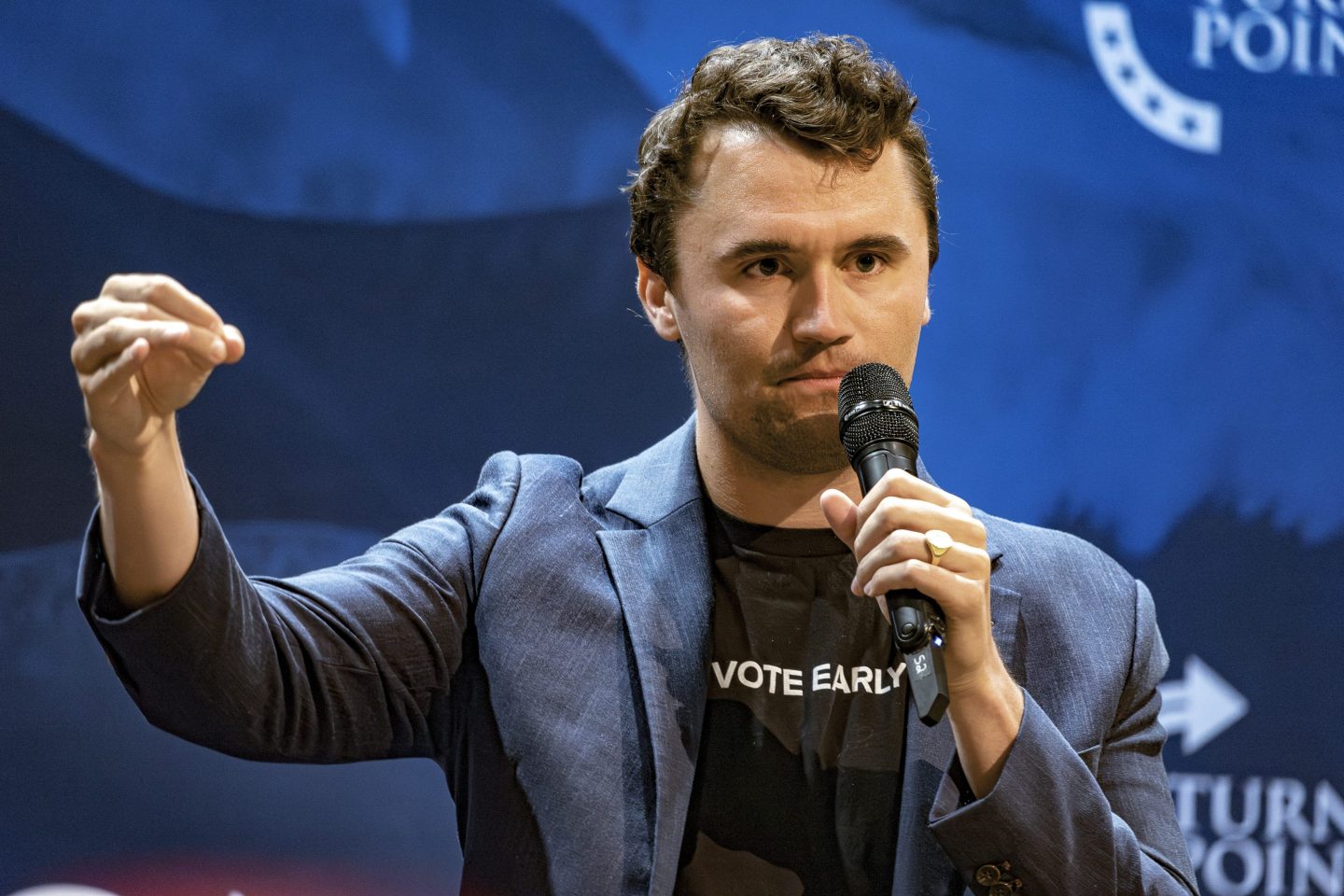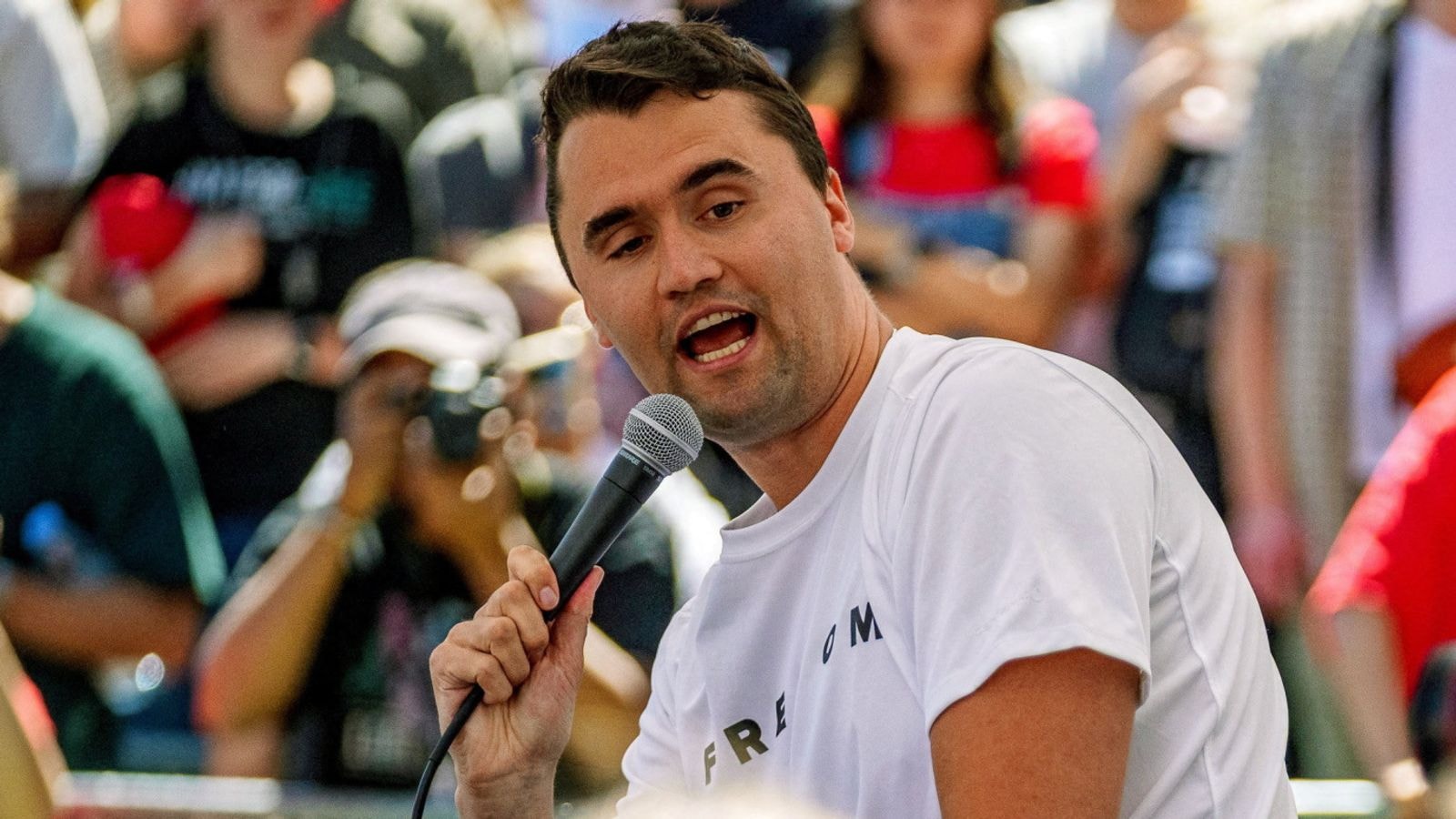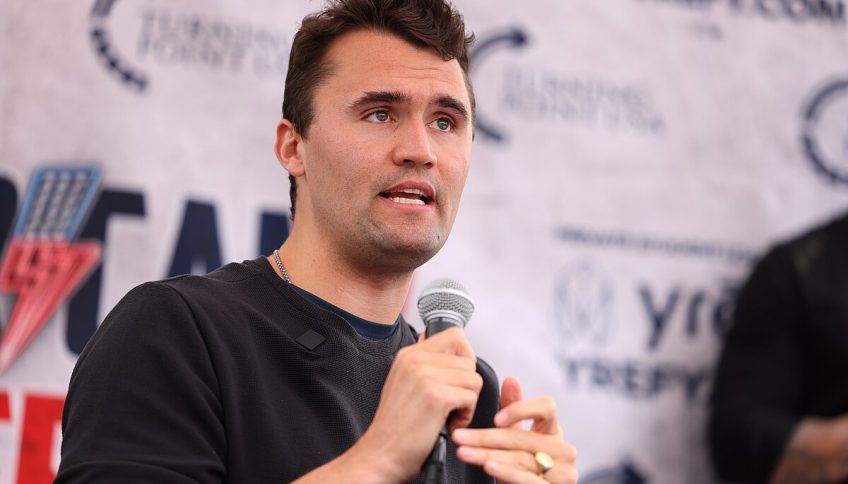A casual Q&A session turns into a national storm — what Charlie Kirk said next stunned the campus.
It began like countless campus events across the country: a microphone, a stage, a speaker, and a room full of students eager—some supportive, others skeptical—to ask hard questions. But within minutes, what should have been a routine Q&A session turned into a cultural flashpoint. Charlie Kirk, founder of Turning Point USA, found himself in the middle of a moment that now defines not only him but the state of political discourse in America.
The video, captured by several attendees and quickly uploaded to social media, shows Kirk fielding questions from an outspoken student who challenged his stance on free speech and equality. Their exchange—sharp, emotional, and sometimes uncomfortable—has since been watched over
Some see it as an example of courage—an honest dialogue that America needs more of. Others call it bullying, claiming Kirk used his platform to dominate a much younger, less experienced speaker. The truth, as always, lies somewhere in between.

Scene One: The Question That Started It All
It began with one student—nervous but determined—stepping up to the microphone. According to eyewitnesses, the student had been sitting near the back of the auditorium, listening quietly for nearly an hour before deciding to speak.
“Mr. Kirk,” the student began, “you talk about freedom and responsibility. But don’t you think your message sometimes ignores people who don’t have the same opportunities as you?”
For a brief moment, there was silence. Kirk looked up, smiled slightly, and said, “That’s a fair question. Let’s talk about it.”
What followed wasn’t a shouting match. It was something deeper—a raw, unfiltered exchange about privilege, opportunity, and the meaning of fairness in modern America.
But as the video shows, tension built quickly. Kirk, known for his fast responses and assertive debate style, countered every point with precision. “Opportunity doesn’t guarantee equality of results,” he argued. “What matters is freedom—the freedom to try, to fail, and to try again.”
The crowd erupted in applause. The student, visibly shaken but composed, fired back: “Freedom for some isn’t freedom for all. If the system’s broken, freedom doesn’t mean much to those left behind.”
It was a powerful moment—two very different visions of America colliding in real time.
Scene Two: The Camera Never Blinks
In today’s world, no conversation stays private for long. Within hours, the video had been clipped, captioned, and uploaded to multiple platforms. Each version told a slightly different story.
One clip, shared by Kirk’s supporters, showed him confidently defending conservative values while the student appeared flustered. Another edit, shared by progressive accounts, portrayed the student as brave and articulate, standing up to a powerful speaker.

The algorithm did the rest.
By morning, “Charlie Kirk debate student” was trending nationwide. News outlets from The Daily Mail to The Washington Post ran pieces analyzing the exchange. TikTok creators began dissecting every gesture, tone, and facial expression, while Twitter (or X) users launched hashtags like
But lost in the digital storm was the most important part—the human story behind the viral moment.
Scene Three: The Student Speaks
Two days after the event, the student—who has asked to remain anonymous—posted a statement on Instagram:
“I didn’t go there to fight. I just wanted to be heard. I wanted to ask why so many people my age feel left out of the American dream. It wasn’t about politics. It was about hope.”
That post received more than 200,000 likes within 24 hours.
Support poured in from all sides—teachers, classmates, even a few conservative commentators who praised the student’s composure. But it also drew harsh criticism. Some accused the student of being “ungrateful,” while others accused Kirk’s team of “platform intimidation.”
Kirk himself responded a few days later on his podcast:
“I respect any young person who asks hard questions. That’s what free speech is about. But we also have to be honest about personal responsibility. You can’t change the world by blaming it.”
His tone was calm, measured. But the public reaction had already taken on a life of its own.
Scene Four: Experts Weigh In
To understand why this one exchange hit such a nerve, we spoke with several experts in communication, sociology, and digital culture.
Dr. Marissa Holt, a media psychologist at UCLA, explains:
“In the age of social media, debates like these become symbols. People don’t just see a conversation—they see their entire worldview reflected back at them. That’s why a single moment can ignite millions of reactions.”
Political analyst Jamal Harris adds:
“Kirk represents a confident, unapologetic conservative voice. The student represents a younger, progressive generation demanding systemic change. When those worlds collide, it’s not just disagreement—it’s identity clashing with identity.”
Indeed, much of the online response wasn’t about the facts of the argument. It was about what each person symbolized.
One side saw a seasoned speaker dismantling flawed logic; the other saw a young voice being silenced by power.
That’s why the video kept spreading—not because of what was said, but because of what people felt.
Scene Five: When the Internet Chooses Sides
The comment sections became digital battlegrounds. On YouTube, debates raged over who “won.” On TikTok, users edited emotional montages to music, turning the moment into a short-film metaphor for generational tension.
Kirk’s supporters framed it as a triumph of logic.
“He destroyed them with facts and calm reason,” one viral post read.
Critics saw something else:
“It wasn’t a debate—it was humiliation dressed up as discussion.”
Even major media figures joined the conversation. Some praised Kirk’s composure under pressure. Others called for more empathy in public debates.
But beyond the noise, one uncomfortable truth emerged: modern America doesn’t just debate ideas—it performs them. Every argument becomes entertainment. Every disagreement becomes content.
Scene Six: The Anatomy of a Viral Moment
Why did this particular clip—among thousands of political debates online—explode in popularity?
According to data from CrowdTally, an analytics firm tracking viral trends, three factors drove its reach:
-
Contrast of Power: A well-known figure versus an ordinary student creates emotional stakes.
-
Clarity of Conflict: The argument—freedom vs. fairness—is universal, easily understood, and deeply emotional.
-
Emotional Authenticity: Neither side appeared rehearsed. It felt real.
Media strategist Olivia Ramos explains:
“Audiences are drawn to moments that feel unscripted. Whether you agree or not, you can’t look away because it feels like watching truth in motion.”
Scene Seven: Beyond Left and Right
As the dust settled, something surprising happened. Independent voices from across the political spectrum began using the clip in classrooms, podcasts, and civic discussions.

At a high school in Texas, a teacher showed the debate to students studying persuasive communication. In Portland, a university media course analyzed how the editing of viral clips shapes public opinion.
One student wrote afterward:
“It made me realize we’re not just arguing about policies. We’re arguing about what kind of people we want to be.”
Perhaps that’s the real significance of this viral moment—it forced people to confront the tone and quality of our national dialogue.
Scene Eight: Kirk Reflects
Weeks later, Kirk addressed the controversy again during a public interview:
“I’ve done thousands of Q&As. Some are tough, some emotional. But if a young person leaves thinking more critically, that’s a win for me. We need disagreement. That’s how democracy breathes.”
He also acknowledged that his style—sharp, confident, and sometimes confrontational—can be polarizing:
“I’m not here to make people comfortable. I’m here to make them think.”
Behind the scenes, sources close to Turning Point USA say the organization has used the moment as a teaching example—training new speakers to handle questions with more empathy while maintaining firmness.
It seems even Kirk himself is evolving.
Scene Nine: The Student’s Second Statement
A month later, the student posted again on social media:
“I still disagree with a lot of what Charlie said. But I respect that he listened. If anything, this showed me how powerful a question can be.”
That line—“how powerful a question can be”—quickly became a viral quote itself, shared by teachers, journalists, and activists across the internet.
It captured something rare in today’s world: humility, growth, and reflection—values often drowned out by outrage.
Scene Ten: America Watches Itself
The Charlie Kirk Q&A became more than a political moment—it became a mirror. It reflected the anxiety, division, and yearning that defines modern America.
Every cheer, every boo, every replayed clip was a small piece of a much larger story about how we talk to each other, and how easily we forget to listen.
Sociologist Dr. Ethan Cho summarizes it best:
“The debate wasn’t really about politics. It was about respect. The student wanted to be heard. Kirk wanted to be understood. The tragedy of our time is that we often confuse those two things.”
Scene Eleven: The Bigger Picture
Beyond the controversy, this viral encounter reveals how technology has reshaped civic life.
Thirty years ago, debates like this stayed on campus. Today, they reach millions overnight, edited and reframed through countless ideological filters.
Social media, once a tool for connection, has become an amplifier of polarization. Yet, paradoxically, it also exposes us to more perspectives than ever before.
Political scientist Angela Torres puts it plainly:
“The internet doesn’t divide us—it reflects the divisions already there. The camera just makes them impossible to ignore.”
Scene Twelve: The Lessons Left Behind
When the lights faded and the hashtags stopped trending, what remained was a question that no one—not even Charlie Kirk—could fully answer:
How do we debate without dehumanizing?
The incident reminded millions that democracy isn’t about perfect answers—it’s about the courage to ask, and the grace to listen.
For Kirk, the viral storm may have been just another day in the arena of ideas. For the student, it was a once-in-a-lifetime experience that tested their voice and conviction. For the rest of us, it was a reminder that disagreement doesn’t have to mean division.
Epilogue: The Camera Turns Off
Months later, the clip still circulates online, resurfacing whenever new controversies ignite. It has become a modern artifact—part cautionary tale, part inspiration.
Some rewatch it to cheer. Others to criticize. But almost everyone who sees it feels something.
And maybe that’s the point.
Because beyond the slogans and the soundbites, what happened that day was profoundly human: one person asking, another answering, both caught in the endless echo chamber of a nation still trying to understand itself.
Final Reflection
The viral Q&A between Charlie Kirk and the student is more than a 90-second clip—it’s a case study in America’s evolving conversation about power, privilege, and participation. It shows how truth, when captured by a phone camera, can become something larger than either speaker intended.
Perhaps someday, when the noise fades and the algorithms move on, we’ll look back and realize that this wasn’t a fight—it was a signal.
A reminder that amid the outrage and applause, what really matters isn’t who “won” the debate, but whether we were truly listening when it happened.
Breaking News: Lucy Martinez fired after viral Charlie Kirk mocking video — student secretly recorded the moment she burst into tears upon hearing the news, and what happened next left the class speechless!

Breaking News: Lucy Martinez fired after viral Charlie Kirk mocking video — student secretly recorded the moment she burst into tears upon hearing the news, and what happened next left the class speechless!
It began as an ordinary morning in Chicago. The corridors of Westview High were buzzing with the usual teenage energy — laughter, sneaker squeaks, half-finished coffees. But for one teacher, the day was about to spiral into something no one in the building would ever forget.
Lucy Martinez, 34, had been teaching English for nearly a decade. Known for her wit, strictness, and surprisingly warm heart, she was one of those teachers students remembered years later — not because she was perfect, but because she was human. She pushed her students to think, question, and feel.
And yet, on an October morning in 2025, Lucy’s name would explode across social media — not for her teaching, but for a moment of laughter that the internet would never forgive.
The Video That Started It All
The clip was only 18 seconds long. Filmed during a casual lunch break, it showed Lucy and a few colleagues discussing the tragic death of public figure Charlie Kirk — a story that had dominated headlines for weeks.
Someone had joked, someone had laughed, and Lucy, in a careless second, had smiled and said words that would cost her everything.
Within hours, the clip hit social media. The caption read:
“Chicago teacher mocks Charlie Kirk’s death — unbelievable lack of respect.”
The outrage was instant.
Thousands of comments flooded in.
Parents called the school. Hashtags trended.
And within 48 hours, Lucy Martinez — a teacher no one outside her community had ever heard of — became the most hated woman in America.
The Backlash: A Nation Divided
In the days that followed, Lucy received more messages than she had in her entire life — half of them filled with anger, the other half with pity.
Some called her heartless.
Others said she was a victim of cancel culture.
But no one really knew what had happened behind that short clip — or how much was missing from the story.
The district issued a statement: “We are aware of the video and are conducting an internal review.”
To the public, it sounded like a death sentence.
And for Lucy, it was.
The Firing: The Moment Everything Collapsed
It was Friday, October 18, 2025.
Lucy arrived at school early, hoping to face the inevitable quietly.
At 9:42 a.m., she was called into the principal’s office.
Inside were three people: the principal, a district HR representative, and a school counselor.

“We’ve completed the review,” the HR officer said softly. “We’ve decided to terminate your employment effective immediately.”
Lucy didn’t argue. She didn’t cry — not yet.
She simply nodded.
Witnesses later said she left the office calmly, almost too calmly, carrying only a small folder and her favorite blue coffee mug.
The Secret Recording: What the Students Saw
What happened next turned everything upside down.
Lucy walked back into her classroom to collect her belongings. A few students were there early for her morning class, unaware of what had just happened.
She smiled at them — a weak, trembling smile.
Then she said quietly, “You guys know I always tell you to speak with kindness… I guess I needed that reminder myself.”
Her voice cracked.
That was when one student — a 16-year-old named Riley Thompson — instinctively started recording on his phone.
The footage he captured would go viral within hours.
It showed Lucy standing by the window, holding her mug tightly, trying not to break down.
Then, as the students watched in silence, she said something that no one expected:
“We all say things we wish we could take back. But if you ever make a mistake… please, please don’t let it define you forever.”
And then she burst into tears.
The Internet Reacts: From Hate to Heartbreak
When Riley uploaded the video to his private group chat, he didn’t expect it to escape.
But someone shared it.
Then another person.

And by nightfall, it was everywhere.
The caption this time read:
“Our teacher got fired today. I think she deserves a second chance.”
The tone of the internet began to shift.
Suddenly, Lucy wasn’t just the villain of the story — she was its victim too.
Comments poured in from around the world:
“She made a mistake, but who hasn’t?”
“This broke me. You can see the regret in her eyes.”
“She doesn’t deserve to lose her whole life over one moment.”
Within 24 hours, Lucy’s name trended again — but this time under #ForgiveLucy.
Behind the Scenes: The Unseen Pressure
While the public debated, Lucy stayed silent.
She avoided interviews, ignored calls from journalists, and refused to make a public apology video.
In a message to a friend that later surfaced, she wrote:
“It’s not about saving my job anymore. It’s about remembering who I am when the noise fades.”
Her words struck a chord with many teachers who felt increasingly afraid to speak freely in classrooms.
One educator commented:
“Lucy’s story is what happens when a 10-second mistake becomes a lifetime punishment. We’re all one viral clip away from losing everything.”
The Turning Point: An Unexpected Visitor
A week later, Lucy returned to the school building — not to teach, but to collect personal items from her desk.
As she walked through the hallways, she noticed something taped to her old classroom door.
It was a handwritten note signed by nearly every student she had ever taught.
In the center, one line stood out in big letters:
“You taught us words have power — now we’re using ours to stand with you.”
For the first time in days, Lucy smiled.
The Interview That Changed Everything
Eventually, Lucy agreed to speak with a small local paper.
Her interview was quiet, reflective, and surprisingly honest.
She didn’t deny what she said.
She didn’t try to justify it.
Instead, she said:
“I was tired, careless, and human. That doesn’t excuse it, but it explains it. What I regret most isn’t the joke — it’s the hurt I caused. I forgot that behind every headline is a family grieving.”
Her statement went viral again — but this time, it was shared with compassion, not fury.
News anchors quoted her. Influencers posted her words.
Even a few of Charlie Kirk’s supporters commented that they appreciated her sincerity.
The Broader Question: When Does Accountability Become Cruelty?
Lucy’s story reopened a nationwide conversation about cancel culture, forgiveness, and the speed of digital judgment.
Experts debated it on television. Psychologists weighed in.

Dr. Maria Chen, a social psychologist from Northwestern University, said:
“We’re living in a time when a person’s worst moment can define their entire existence online. Lucy’s breakdown was powerful because it reminded people that behind every viral outrage is a beating heart.”
And she was right.
The footage of Lucy crying didn’t just humanize her — it exposed the fragility of modern morality, the way empathy can vanish when filtered through a phone screen.
Riley’s Confession: The Student Who Recorded It All
Months later, Riley Thompson — the student who had filmed Lucy — finally spoke out.
He said he hadn’t planned to share the video widely.
“I just wanted people to see that she wasn’t a monster,” he explained in an interview.
“I never thought it would go viral.”
He admitted that part of him felt guilty — but also proud.
Because the world had finally seen the teacher he knew: flawed, emotional, but kind.
Riley’s video now has over 80 million views across platforms.
The Message from the Kirk Family
In an unexpected turn, a spokesperson for the Kirk family released a short statement:
“We do not condone what was said, but we recognize the pain that can come from one careless moment. We hope Mrs. Martinez finds peace and healing.”
The statement was brief but powerful.
For Lucy, it was the first time she cried tears of relief instead of shame.
Life After the Storm
Today, Lucy Martinez lives quietly outside Chicago. She tutors students online, helps out at local literacy programs, and avoids the spotlight that once burned her life down.
She still gets messages every week — some kind, some cruel — but she reads the kind ones twice.
When asked if she would ever return to teaching full-time, she smiled gently and said:
“Maybe. But for now, I’m teaching myself what forgiveness really means.”
What Her Story Teaches Us
Lucy’s fall — and partial redemption — became a mirror for society.
It forced millions to ask hard questions:
-
How fast are we to judge?
-
How often do we forget the full story?
-
And when did we start confusing accountability with vengeance?
Her story isn’t just about a teacher in Chicago.
It’s about every person who has ever made a mistake in a world that never forgets.
Because in the end, Lucy Martinez didn’t just lose her job — she exposed a truth we all needed to see:
“The internet never forgets… but maybe people still can forgive.”
Epilogue: The Last Lesson
Six months after her dismissal, Lucy was invited to speak at a community event about digital empathy.
When she walked on stage, she saw some of her former students sitting in the front row — including Riley.
She took a deep breath and began,
“Once, I told my students that every word we speak has an echo. I learned that lesson the hardest way possible. But I also learned that forgiveness echoes too — if we let it.”
The audience gave her a standing ovation.
And in that moment, for the first time since that fateful day in October, Lucy Martinez felt like a teacher again.







